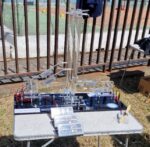In the early hours of 6 February, an earthquake of magnitude 7.8 was followed just eleven minutes later by an aftershock of magnitude 6.7. A few hours later, an earthquake of magnitude 7.5 – and occurring relatively close to the first quake – but apparently on another seismic fault system nearby, struck the area again.
In the first 24 hours, more than 500 aftershocks of magnitude 2 and above had already been recorded, seventeen of them of magnitude 5-6, enough to pose a risk to already damaged buildings and infrastructure and to rescue efforts.
This earthquake, which occurred in the southwest of Turkey, very close to the border with Syria – a country that has been plagued by civil war for more than a decade – has been very destructive, most likely due to various causes – some geological and others human – and at the time of writing the death toll has already exceeded six thousand, a figure that could continue to rise in the coming hours and days.
At this point, why has an earthquake of this magnitude occurred in Turkey? Turkey is one of the most seismically active areas of our planet, as there are several tectonic plates (in its immediate vicinity, four: Eurasia, India, Africa, Arabia, and a small one, where the earthquake occurred). And a small one, where the earthquake occurred, which is the Anatolian plate) and it is precisely between the limits of these plates where the greatest geological activity on our planet is concentrated.
In these contact zones, great stresses are generated in the rocks, which are capable of folding and fracturing them due to the enormous tensions, because let’s not forget that tectonic plates move with respect to each other, sometimes pushing each other, sometimes moving away from each other, and sometimes passing next to each other.
And it is in these fractures in our planet, which we know as seismic faults, that earthquakes occur. We have to imagine that these fractures divide two blocks of rock and that sometimes one slides relative to the other, but when they are blocked, they accumulate elastic energy in the rocks that is suddenly released when a certain threshold of stress is exceeded, as when we release the rubber of a slingshot to throw the rock, and a displacement is produced in the seismic fault.
Much of this energy is released as seismic waves, which we recognise on the surface as earthquakes because of the vibration or shaking of the ground. Seismic waves also move through the Earth’s interior, reaching other parts of the planet where even if the earthquake is not felt, instruments can detect it, especially large earthquakes.
Turkey has historically been hit by earthquakes. It is true that this area has not had a similar earthquake since 1882, when more than 7000 people died, but in Turkey’s recent history, there have been major earthquakes in other areas as well, such as the 1939 Erzincan earthquake, which is estimated to have killed more than 32,000 people and was of a similar magnitude to this February’s, and the 1999 Izmit earthquake, which killed more than 17,000 people.
Why was this earthquake so devastating and deadly? It is probably due to many factors, and it is too early to say for sure. The first was that because it was at night, most people were indoors, and when it collapsed, they were caught indoors with no time to react. The second, which many scientists and engineers are beginning to point to, is the quality of construction in this area of Turkey and also in Syria, which in some cases can be very poor, despite the fact that in this case Turkey has a great seismic-resistant code to apply to buildings, although the lack of controls can make this control ineffective. And finally, we have to take into account geological factors: the magnitude of the earthquake, places where seismic amplification phenomena may have occurred due to the geology of the subsoil, liquefaction problems where the soil loses a lot of consistency…
These causes must make it clear to us that responding to a seismic hazard has to be approached from many perspectives, not only from geology, but also from urban planning, engineering, awareness and the work of the administrations.
Right now the most important thing is to rescue the people who have been trapped, treat the injured and try to help all the people who have lost their homes and their families, so that gradually we can start on the road to reconstruction, which will probably be long and very hard.
I am sure that in the coming months we will begin to see studies that will help us to better understand why and how this earthquake happened, and, of course, to understand the causes of this devastation, from which we will have to learn lessons to try to prevent a tragedy of this magnitude from happening again.
Nahum Méndez Chazarra – Geologist













